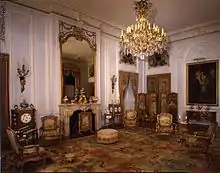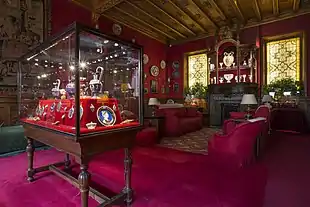Alice Charlotte von Rothschild
Alice Charlotte von Rothschild (17 February 1847 – 3 May 1922), otherwise referred to as 'Miss Alice', was a socialite and member of the Rothschild banking family of Austria. Born in Frankfurt, she was the eighth and youngest child of Anselm von Rothschild (1803–1874) and Charlotte Rothschild (1807–1859) and younger sister to the British politician, Baron Ferdinand de Rothschild. She was a small child when her family moved to Vienna, where her father took over management of the family-owned S M von Rothschild bank.
Alice Charlotte von Rothschild | |
|---|---|
.png.webp) | |
| Born | February 17, 1847. Frankfurt |
| Died | May 3, 1922 (aged 75) |
| Nationality | German |
| Occupation | Socialite |
| Known for | Member of the Rothschild banking family of Austria |
Family life
Alice von Rothschild's mother was the daughter of Nathan Mayer Rothschild of London and as a result the family would have close connections to the English branch of the Rothschild family. Her brother Ferdinand, with whom she was very close, studied at Cambridge University and married an English cousin.

Her mother died when she was twelve and as a result of her busy father who travelled constantly, she spent a lonely childhood, living with various relations. Photographs of Alice as a girl and a young woman show her "with a broad brow, firm full lips and a strong chin, not conventionally pretty, but full of character".[1] This sense of character is what makes Miss Alice so renowned for her 'formidable' reputation. Girouard states that it is down to two events that helped convert the young, girlish Miss Alice to her strong older self, that being first acting as hostess for her brother Ferdinand, at Leighton House and then at Waddesdon Manor - and secondly being after the death of her father in 1874, leaving her a wealthy woman. Much to the family's surprise, she was left the original Rothschild family home in Frankfurt alongside a house and estate at the Grunburg, just outside.
When her brother Ferdinand began the construction in 1874 of Waddesdon Manor in Buckinghamshire England, Alice acquired a nearby property at Eythrope for herself. There, between 1876 and 1879, she had a park and garden created and a house built near the river called Eythrope Pavilion. Although, as Alice had suffered from rheumatic fever, she had been advised not to sleep near water as dampness would aggravate her health problem meaning her house was built for solely for daytime occupation. Therefore, at nights she returned to stay at Waddesdon Manor.
Inheritance
In late 1898, following the death of her brother, Baron Ferdinand de Rothschild, Alice inherited Waddesdon Manor and his London House. During World War I she had the formal gardens at Waddesdon and Eythrope given over to the growing of vegetables for the less fortunate. The Eythrope Pavilion was still maintained but now as even more of an occasional retreat. As her health declined she spent more of her time at her magnificent château, "Villa Victoria", in the balmier climate of the town of Grasse in the Alpes-Maritimes département in France. Her property was located about 12 miles (19 Kilometers) inland, north of the Mediterranean coast and here she created an enormous garden that employed more than one hundred gardeners. A spinster, she wanted to be near family, and her château was close to Cannes, where her cousin Laura Thérèse von Rothschild, widow of James-Edouard de Rothschild owned the Villa Rothschild, Cannes, and only 34 miles (55 kilometers) from Villa Ephrussi de Rothschild, the seaside estate owned by another cousin, Béatrice Ephrussi de Rothschild.
Queen Victoria vacationed in Grasse and visited Villa Victoria. According to the book The Rothschild Gardens by Miriam Rothschild, at the turn of the century, Alice Rothschild spent the equivalent of nearly half-a-million pounds (Sterling) annually on her gardens and grounds at Grasse. Imperious in nature, Alice was a strong-willed person who spoke her mind. According to a 2001 book by author Michael Nelson: "the Queen stepped on a lawn and across a flower-bed [at Waddesdon Manor], inadvertently crushing several plants. The baroness could not contain herself and roughly told the sovereign in effect to 'Get out'. Thereafter the Queen always referred to her as 'The All-Powerful One'."
Collecting and innovating conservation

Like most other members of the Rothschild family, Alice Rothschild was a collector of art. While she acquired paintings, sculptures and objets d'art, Alice von Rothschild also had a unique collection of smoking pipes, including French, Spanish and Italian examples from the 17th century. The collection was donated to the town of Grasse, France on her death in 1922, where her winter property was based. The château in Grasse later became the hotel "Parc Palace", where the famous French actor Gérard Philipe was raised. Alice von Rothschild willed Waddesdon Manor to James Armand de Rothschild. Avenue Rothschild in Grasse is named in her honor.
Along these same lines, Miss Alice was also an avid and careful collector for Waddesdon Manor, and added elements to Ferdinand's previous collection in order to fill the gap left when he bequested much of his renaissance artworks to the British Museum (now referred to as the Waddesdon Bequest). For instance, the helmet of the emperor Charles V is a prominent contribution of Miss Alice's to the Armoury Corridor, upstairs in the Bachelor's Wing. She regarded herself as 'the protector' of Ferdinand's inheritance and is famous for establishing ‘Miss Alice’s Rules' – guidelines for the care and preservation of the collections which even today form the foundation for those conservation rules of the National Trust.[2]
Sources
References
- Girouard, Mark (1998). A Hundred Years at Waddesdon. Waddesdon Manor: Rothschild Waddesdon Ltd. p. 50.
- "Votes for Women". Retrieved 29 Nov 2018.
- Rothschilds at Waddesdon Manor by Dorothy de Rothschild. Viking Penguin (1979) ISBN 0-670-60854-8
- The Rothschild Gardens by Miriam Louisa Rothschild (1998) Harry N. Abrams, Inc., London ISBN 0-8109-3790-5
- Queen Victoria and the Discovery of the Riviera by Michael Nelson (2001) I.B. Tauris, London ISBN 1-86064-646-8
- See also the list of references at Rothschild banking family of Austria and Rothschild banking family of England